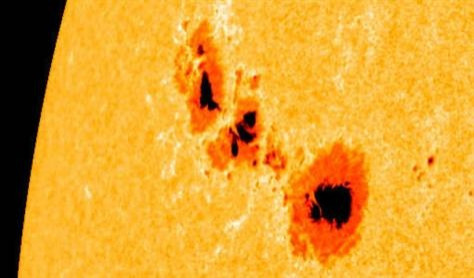Solar Flare 2011: Huge Sun Storms Blast Earth, Could Interrupt GPS Signals, Radio Communications [VIDEO]

Particles that were blasted by the sun during a powerful solar flare over the weekend have reached our planet, according to the U.S. National Oceanic and Atmospheric Administration (NOAA), causing geomagnetic storms on Earth that may disrupt GPS signals, radio communications and power grids.
The particles reached Earth at 8:37 a.m. EDT on Monday, prompting moderate geomagnetic storms at lower latitudes and more powerful storms closer to the Earth's poles. So far, NOAA reports there have been no communication interruptions.
Still, scientists say the storm may be a treat for astronomers, as it is expected to trigger auroras, also known as Northern Lights, over northern Europe and Russia.
Aurora watchers in Asia and Europe are most favorably positioned for this event, though it may persist long enough for viewers in North America, officials with NOAA's Space Weather Prediction Center (SWPC) wrote in an update on Monday.
On Saturday, the Sun unleashed a solar flare known as a coronal mass ejection (CME), which are enormous clouds of solar plasma capable of traveling through space at three million miles per hour or more. The recent storm erupted from a region known as sunspot 1302, NOAA reports. Sunspots are temporary dark patches on the solar surface caused by intense magnetic activity.
Region 1302 remains capable of producing more activity and will be in a favorable position for that activity to have impacts on Earth for the next 3-5 days, SWPC officials said.
Sunspot 1302 has reportedly been particularly active, releasing multiple X-class fires - the most powerful type -- over the past few days. Scientists say we are entering the beginning of solar flare season, a rotation that lasts about 11 years, and the sun is now rousing itself from an extended inactive phase.
A solar flare is caused when intense bursts of radiation come from the release of magnetic energy associated with sunspots. A CME occurs when the outer solar magnetic fields are closed, causing the confined solar atmosphere to suddenly release bubbles of gas and magnetic fields.
Just last month, NASA reported the sun had spouted an X6.9 solar flare, which was the most powerful solar storm recorded since December 2006. Scientists expect activity in the current cycle, known as Solar Cycle 24, to peak around 2013.
© Copyright IBTimes 2024. All rights reserved.





















